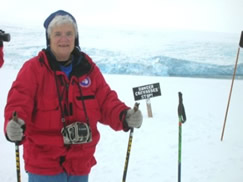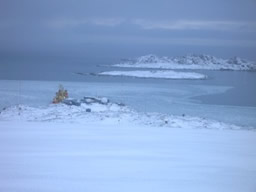This morning I woke up to the sounds of engine thrusters, dockside voices and lo and behold, we were at Palmer Station! Palmer is the U.S. station on the Peninsula, actually on Anvers Island along the west side of the peninsula. You may know McMurdo Station, which is actually on the continent, near the South Pole. Different station, same kinds of crazy people inhabit it, however.
Actually, the station seems more like a small college campus, with many different projects going on, uncombed people in casual clothes in offices and labs throughout wait a minute! That sounds like where I work. So “crazy” doesn’t look so crazy to me anymore. Back to the subject. Palmer was originally a military station, now a mostly biological research station. There are studies involving subjects such as sea life (krill and their friends), sea mammals (‘charismatic megafauna’) and penguins. Check out the Palmer Station website for more info on that.
Palmer Station Tour:
I had an opportunity to talk with one of the station’s project leaders, Glenn Grant in the “Terra Lab” (delineated from the “Bio Lab”, get it?). This lab specializes in beyond Biology studies involving geophysics, earth science and atmospheric science. On this outpost-on-a-rock, they find they are strategically located to receive from satellites and the clean clear air itself, the most interesting data about events happening all over the earth. Glenn described in a nutshell 3 of the projects going on there. I will do my best to interpret it here for you. (Feel free to send me feedback I’ll disclaim, I mean, will print corrections any time). In any event, get the ‘how cool is this!’ from it:
Seismic System: This receiving instrument is ‘out in the backyard’ of the building (mind you, this whole community of small buildings is built on a rough glacial moraine the rock field left behind by a receding glacier). The computers inside the building are able to detect seismic activity of any kind in any part of the world. Imagine that!! Because of where they are and the sensitivity of the instrument, they could know within maybe a half hour that an earthquake occurred in Siberia! Actually, the U.S. Geological Survey in Golden, CO knows first that the earthquake occurred, but USGS contacts this office on Palmer to have them look at the data readout to tell them more about the event, their instrument is so sensitive and unencumbered by other events such as a near-city-or-civilization site might pick up. One data sheet, for instance, showed some ‘scratches’ that were interpreted to be some ice breaking off the glacier they knew it was not an earthquake. Ah, this was amazing to me. But there’s more….
VLF System: VLF stands for “Very Low Frequency” radio waves. This instrument is used to catch and interpret the radio waves sent out by lightening strikes on the earth. Every time there is a lightening strike, radio waves are deflected from the earth’s surface to the Ionosphere (the band just beyond the earth’s atmosphere and stratosphere, populated by charged ions do you know how they got there?). Regularly, the radio waves get through a ‘hole’ in the ionosphere (naturally occurring), reaching to the Magnetosphere (next after the Ionosphere), and those waves follow the earth’s magnetic pathways to the earth’s magnetic poles. When they come back to earth, they make a “pop” sound on this instrument’s receiver Palmer being close enough to the Pole to get it. Glenn turned up the receiver while we visited, and it was very effective background ‘noise’, constant ‘popping’ with an occasional zzzzzeeeeeeeeeeeoooooooooop high pitch to low pitched whine depending on the frequency of the wave. The practical use for this is in wavelength communications as well as understanding the effects of the Iono/Magneto border on the satellites traveling along it, which Glenn says many of them do. Whatever it is used for, it is way cool, and we’ll be hearing more on this from our Palmer passenger Morris Cohen (dropped off at Palmer for 2 weeks), on the trip back to Chile.
TeraScan: This instrument and its accompanying software, via air force weather satellites, gives visible images on a map format, of things/events that ‘give off color’ over a large part of Antarctica and its surrounding waters, up to South America. It ‘sees’ through a spectrum sensor, and can tell us about things like krill or algal blooms, weather (via thick clouds) or ice forming along the borders and bays of the continent. One of the printouts showed the occurrence of an aurora over mid-Antarctica in the past week. Although Glenn didn’t see it, he could contact his friend at McMurdo Station and say, “So, how was that aurora last night?? Pretty nice, huh? Looked huge!”
Nuclear Blast Big Brother System: In the-room-that-no-one-enters, there is yet another sensor that can sense certain particles in the air that tells if a nuclear blast has been detonated within a certain range of Antarctica. To detonate a nuclear blast down here (just to ‘try it out’) violates in a huge way all kinds of treaties and important rules-of-the-world so they don’t want anyone to even think about interfering with the instruments. That’s fine with me. It made me sad to think anyone would mess with the ‘cleanest air in the world’.
Back to some Biology, and Getting to Know… Labidiaster annulatus. Among the places we were able to linger was the base’s aquarium room. We were privileged to feed and watch the creatures in the aquarium enjoy their meal from a ziplock Bag-o-Krill.
One of the most amazing Antarctic sea stars is the large, multi-armed krill-eating star, Labidiaster, which can have about 50 arms and an overall diameter of about one and a half to two feet across! These formidable beasts have long arms covered with small claw-shaped structures with jagged teeth, known as pedicellariae, which they use to capture and snag small moving (and swimming!) prey, such as krill and other small mobile animals. Small prey that are unfortunate enough to settle on the surface of Labidiaster are also captured by these claw-like structures. Prey are moved over to the tube feet or ensnared by the tentacle-like arms and brought down to the mouth where they are promptly eaten. In the wild, these often climb up on high platforms so that they can hold their arms up into the water to capture prey. Labidiaster also eats many other smaller animals, including limpets and brittle stars. [Thanks to Dr. Chris Mah for this graphic description and digital images of this starfish. Chris also reports, seeing this star alive and in ‘habitat’ mode was worth suffering through the Drake Passage.]
Don't hesitate to email
questions to us at outreach@lmg.usap.gov
|
|
Longitude/Latitude:
S64° 46.479’ W64° 03.307’
Temperature:
Wind: 5kn
Air Temp: -0.2°C Wind Chill: -5.0°C
Menu:
Mexican cuisine at Palmer Station including quesadillas, homemade salsa, fresh guacamole (how do they do that?!!?!), and wine; Spaghetti & meatballs, tortellini primavera, carrots, salad, flan, pecan pie, chocolate covered squares.
Photos:

Labidiaster traps some krill handed to it on long forceps [Photo by Chris Mah]

…and then folds up around the food to transport to its mouth, then eat it!
[Photo by Chris Mah]

Izzy Williams led the indomitable troops up the glacier at Palmer Station.
[Photo by Ellen Bailey On The Glacier]

The L.M. Gould in the harbor at Palmer Station, May 2006 [Photo by Ellen Bailey from The Glacier]

Wendy, the chef at Palmer Station what a gig!!
[Photo by Ellen Bailey]

This fur seal’s unspeakable handsomeness speaks for itself.
[Photo at Palmer Sta. by Susie Balser]
|




